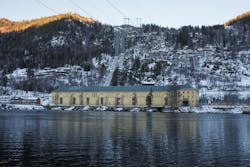Hydropower will supply 40 percent of Norwegian Silicon Metal plant’s electricity
Hydropower and renewable energy firm Statkraft will supply nearly half of the electricity need at Wacker’s silicon metal production site at Holla, Norway.
Statkraft’s agreement with chemical firm Wacker covers supply of 2.35 TWh to the Holla site between January 2022 and December 2027.
Approximately 525 GWh of the power supplied by Statkraft will be from the Svean hydropower plant under the PPA.
Wacker produces silicon metal, in an energy intensive process comparable to steel production, at the Holla site. Silicon is needed to produce silicones and hyperpure polysilicon.
“Switching to green power in our production is an important lever for achieving our sustainability goals,” Wacker CEO Christian Hartel said. “The Holla site is the first step. In the short to medium term, we intend to steadily expand our green power portfolio with further purchases in Norway and Europe.”
Norway is the fourth larger silicon producting nation, after China, Russia and Brazil. The produced metals are used in fabrication of semiconductors and solar energy cells.
Statkraft owns and operates about 237 hydropower plants in Norway.
About the Author
EnergyTech Staff
Rod Walton is head of content for EnergyTech.com. He has spent 17 years covering the energy industry as a newspaper and trade journalist.
Walton formerly was energy writer and business editor at the Tulsa World. Later, he spent six years covering the electricity power sector for Pennwell and Clarion Events. He joined Endeavor and EnergyTech in November 2021.
He can be reached at [email protected].
EnergyTech is focused on the mission critical and large-scale energy users and their sustainability and resiliency goals. These include the commercial and industrial sectors, as well as the military, universities, data centers and microgrids.
Many large-scale energy users such as Fortune 500 companies, and mission-critical users such as military bases, universities, healthcare facilities, public safety and data centers, shifting their energy priorities to reach net-zero carbon goals within the coming decades. These include plans for renewable energy power purchase agreements, but also on-site resiliency projects such as microgrids, combined heat and power, rooftop solar, energy storage, digitalization and building efficiency upgrades.
